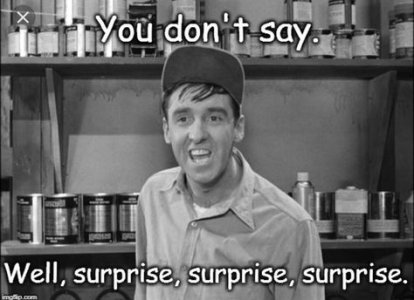You are using an out of date browser. It may not display this or other websites correctly.
You should upgrade or use an alternative browser.
You should upgrade or use an alternative browser.
OldTimer’s Dugout - Off Topic Thread
- Thread starter OldTimer
- Start date
Halph66
We should've gotten the live chicken.
- Joined
- Sep 2, 2012
- Messages
- 14,972
- Likes
- 50,931
Generally, a starting pitcher should not start on Day Two if they pitched even just the first inning on Day One before a rainout—unless they threw very few pitches and the team believes he's still fresh.A 23-pitch, 1 inning start
Why Not Start Him Again?
- Arm Health and Recovery: Starting pitchers typically follow a strict rest schedule (usually 4–5 days) to avoid injury. Even a short outing disrupts this cycle.
- Workload Management: Even if it's just one inning, the warmup, mental prep, and effort involved are nontrivial. It's not the same as a bullpen session.
- Alternatives Available: Teams often have enough depth to start a different pitcher, especially early in the season.
Exceptions
- If the pitcher only threw very few pitches (under 20) and the team is comfortable with the medical and performance risk, they might use him again.
- This is more likely in high-stakes games, like playoffs, or if the team is short on options.
Historically, Major League Baseball (MLB) teams have been cautious about reusing a starting pitcher on the day following a rainout, even if the pitcher only threw a single inning. This caution stems from concerns about arm health and the disruption of the pitcher's routine.
Historical Precedents:
While specific instances of a starting pitcher throwing one inning before a rainout and then starting the next day are rare and not well-documented, the general practice has been to avoid such scenarios. Teams typically prefer to adjust their rotation rather than risk the health of a pitcher by having him start on consecutive days.
Managerial Considerations:
- Pitch Count: If a pitcher throws a minimal number of pitches (e.g., under 20), some managers might consider allowing him to start the next day.
- Game Importance: In high-stakes games, such as during the playoffs, managers might be more inclined to use a pitcher on short rest.
- Rotation Depth: Teams with limited starting pitching options might have to consider using a pitcher on consecutive days, though this is generally avoided.
While there might be exceptional cases, the prevailing practice in MLB is to avoid starting a pitcher on consecutive days, even if the initial outing was brief. This approach prioritizes the long-term health of the pitcher and maintains the integrity of the team's rotation.
Your assertion that MLB managers would not follow suit with CTV's and CFA's decision in not supported by history.
ArdentVol
need to escape the oates field
- Joined
- Dec 6, 2019
- Messages
- 9,806
- Likes
- 20,865
Halph66
We should've gotten the live chicken.
- Joined
- Sep 2, 2012
- Messages
- 14,972
- Likes
- 50,931
Orange.
Pocket presents 🍊
- Joined
- Nov 24, 2021
- Messages
- 29,968
- Likes
- 176,446
VolPack22
Jessica Alba wears my Daddy hat
- Joined
- Aug 11, 2014
- Messages
- 39,007
- Likes
- 106,678
It’s not supported by history because they always refuse to do it, thus little to no history to go off of. Pitchers also used to throw complete games routinely with fewer injuries. But we have guys now throwing fewer pitches but more catastrophic injuries on an annual basis. Not every human’s body is created equal and the fact every pitcher is treated the same has never made sense. Some bodies can handle the workload and some can’t. Doyle routinely hits around 100 pitches each outing. He seems like the type of dude that could handle a shorter outing tomorrow. Against Florida, Nate Snead pitched 37 pitches in Game 1 and 31 pitches in Game 3. But I suppose they prioritized his health in that series.Generally, a starting pitcher should not start on Day Two if they pitched even just the first inning on Day One before a rainout—unless they threw very few pitches and the team believes he's still fresh.
Why Not Start Him Again?
- Arm Health and Recovery: Starting pitchers typically follow a strict rest schedule (usually 4–5 days) to avoid injury. Even a short outing disrupts this cycle.
- Workload Management: Even if it's just one inning, the warmup, mental prep, and effort involved are nontrivial. It's not the same as a bullpen session.
- Alternatives Available: Teams often have enough depth to start a different pitcher, especially early in the season.
Exceptions
- If the pitcher only threw very few pitches (under 20) and the team is comfortable with the medical and performance risk, they might use him again.
- This is more likely in high-stakes games, like playoffs, or if the team is short on options.
Historically, Major League Baseball (MLB) teams have been cautious about reusing a starting pitcher on the day following a rainout, even if the pitcher only threw a single inning. This caution stems from concerns about arm health and the disruption of the pitcher's routine.
Historical Precedents:
While specific instances of a starting pitcher throwing one inning before a rainout and then starting the next day are rare and not well-documented, the general practice has been to avoid such scenarios. Teams typically prefer to adjust their rotation rather than risk the health of a pitcher by having him start on consecutive days.
Managerial Considerations:
Conclusion:
- Pitch Count: If a pitcher throws a minimal number of pitches (e.g., under 20), some managers might consider allowing him to start the next day.
- Game Importance: In high-stakes games, such as during the playoffs, managers might be more inclined to use a pitcher on short rest.
- Rotation Depth: Teams with limited starting pitching options might have to consider using a pitcher on consecutive days, though this is generally avoided.
While there might be exceptional cases, the prevailing practice in MLB is to avoid starting a pitcher on consecutive days, even if the initial outing was brief. This approach prioritizes the long-term health of the pitcher and maintains the integrity of the team's rotation.
Your assertion that MLB managers would not follow suit with CTV's and CFA's decision in not supported by history.
Drewbydoo
Drew
- Joined
- Apr 30, 2022
- Messages
- 5,990
- Likes
- 14,036
Halph66
We should've gotten the live chicken.
- Joined
- Sep 2, 2012
- Messages
- 14,972
- Likes
- 50,931
So if 100 coaches out of 100 coaches choose not to start a pitcher on day 2 after a short outing the day before there is no history of their decision. Did I get that right? I just can't.It’s not supported by history because they always refuse to do it, thus little to no history to go off of. Pitchers also used to throw complete games routinely with fewer injuries. But we have guys now throwing fewer pitches but more catastrophic injuries on an annual basis. Not every human’s body is created equal and the fact every pitcher is treated the same has never made sense. Some bodies can handle the workload and some can’t. Doyle routinely hits around 100 pitches each outing. He seems like the type of dude that could handle a shorter outing tomorrow. Against Florida, Nate Snead pitched 37 pitches in Game 1 and 31 pitches in Game 3. But I suppose they prioritized his health in that series.
Key Reasons for the Rise in Pitcher Arm Injuries:
- Increased Velocity:
- Pitchers today throw significantly harder on average than in the past.
- Higher velocity increases stress on the elbow and shoulder, raising the risk of injuries like UCL tears (leading to Tommy John surgery).
- Specialization & Year-Round Throwing:
- Young athletes are increasingly specializing in baseball early and playing year-round.
- This reduces rest and recovery time and increases cumulative stress on the arm.
- Emphasis on Breaking Pitches at a Young Age:
- Sliders and curveballs place extra strain on growing arms, and kids are throwing them earlier.
- Max Effort Pitching Philosophy:
- Modern coaching and training often emphasize throwing at or near max effort every pitch, which wears down the arm faster.
- More Advanced Imaging & Reporting:
- Increased awareness and better medical imaging catch more injuries that might have gone undiagnosed in the past.
Counterpoint – Better Rehab and Recovery:
While injuries have increased, medical treatment has improved:- Tommy John surgery now has an ~80–90% success rate.
- Pitch count monitoring and data analytics help identify risk factors earlier.
Halph66
We should've gotten the live chicken.
- Joined
- Sep 2, 2012
- Messages
- 14,972
- Likes
- 50,931
Get in the cage and practice.

 www.facebook.com
www.facebook.com

141K views · 19K reactions | The EZ Curve Balls are CRAZY! . @platecrate . The Best Training Balls for Working Offspeed and Barrel Control . #baseball #trending #baseballlife #thebullpentraining #platecrate #baseballplayer | The Bullpen Training
The EZ Curve Balls are CRAZY! . @platecrate . The Best Training Balls for Working Offspeed and Barrel Control . #baseball #trending #baseballlife #thebullpentraining #platecrate #baseballplayer.
 www.facebook.com
www.facebook.com
W.TN.Orange Blood
Well-Known Member
- Joined
- Aug 10, 2012
- Messages
- 154,833
- Likes
- 416,458
Halph66
We should've gotten the live chicken.
- Joined
- Sep 2, 2012
- Messages
- 14,972
- Likes
- 50,931
VolPack22
Jessica Alba wears my Daddy hat
- Joined
- Aug 11, 2014
- Messages
- 39,007
- Likes
- 106,678
Lord have mercy. It’s not even the pitch count that’s the issue. It’s the type of pitches being thrown and high stress pitches. Strider tore his arm up last season in the first game of the season. If an injury is going to happen, then it’s going to happen. You can’t just baby everyone. If the kid wants to pitch tomorrow then just let him pitch. It won’t be the end of the world and it won’t ruin his schedule. Like I said, it’s literally just a one-off, one week deal. You want to blow a gasket over trying to get 3 more innings out of guy whenever this entire weekend has gone toSo if 100 coaches out of 100 coaches choose not to start a pitcher on day 2 after a short outing the day before there is no history of their decision. Did I get that right? I just can't.
Key Reasons for the Rise in Pitcher Arm Injuries:
- Increased Velocity:
- Pitchers today throw significantly harder on average than in the past.
- Higher velocity increases stress on the elbow and shoulder, raising the risk of injuries like UCL tears (leading to Tommy John surgery).
- Specialization & Year-Round Throwing:
- Young athletes are increasingly specializing in baseball early and playing year-round.
- This reduces rest and recovery time and increases cumulative stress on the arm.
- Emphasis on Breaking Pitches at a Young Age:
- Sliders and curveballs place extra strain on growing arms, and kids are throwing them earlier.
- Max Effort Pitching Philosophy:
- Modern coaching and training often emphasize throwing at or near max effort every pitch, which wears down the arm faster.
- More Advanced Imaging & Reporting:
- Increased awareness and better medical imaging catch more injuries that might have gone undiagnosed in the past.
Counterpoint – Better Rehab and Recovery:
While injuries have increased, medical treatment has improved:
- Tommy John surgery now has an ~80–90% success rate.
- Pitch count monitoring and data analytics help identify risk factors earlier.
Halph66
We should've gotten the live chicken.
- Joined
- Sep 2, 2012
- Messages
- 14,972
- Likes
- 50,931

480K views · 6.5K reactions | El objetivo era atrapar la pelota a pesar de todo. 😅 | By MLB Español | Facebook
El objetivo era atrapar la pelota a pesar de todo. 😅
 www.facebook.com
www.facebook.com
Halph66
We should've gotten the live chicken.
- Joined
- Sep 2, 2012
- Messages
- 14,972
- Likes
- 50,931
Yep you are the expert. The rest of the MLB and college coaches have no clue. You should quit your day job and manage a team.Lord have mercy. It’s not even the pitch count that’s the issue. It’s the type of pitches being thrown and high stress pitches. Strider tore his arm up last season in the first game of the season. If an injury is going to happen, then it’s going to happen. You can’t just baby everyone. If the kid wants to pitch tomorrow then just let him pitch. It won’t be the end of the world and it won’t ruin his schedule. Like I said, it’s literally just a one-off, one week deal. You want to blow a gasket over trying to get 3 more innings out of guy whenever this entire weekend has gone toschedule-wise due to inclement weather.
VolPack22
Jessica Alba wears my Daddy hat
- Joined
- Aug 11, 2014
- Messages
- 39,007
- Likes
- 106,678
Nolan Ryan threw harder than anyone and AVERAGED 127 pitches at the age of 42. He also once threw 235 pitches in a game, then 3 days later pitched 6 innings. I don’t want to hear anything about the high velocity being the issue. Some guys can do it and some can’t. There is way too much pacifying of athletes nowadays and everyone just wants to assume they can’t do something, so they completely take the option away from them.
W.TN.Orange Blood
Well-Known Member
- Joined
- Aug 10, 2012
- Messages
- 154,833
- Likes
- 416,458
VolPack22
Jessica Alba wears my Daddy hat
- Joined
- Aug 11, 2014
- Messages
- 39,007
- Likes
- 106,678
Orange.
Pocket presents 🍊
- Joined
- Nov 24, 2021
- Messages
- 29,968
- Likes
- 176,446
Halph66
We should've gotten the live chicken.
- Joined
- Sep 2, 2012
- Messages
- 14,972
- Likes
- 50,931
The everyone that you are speaking of are the ones that are directly impacted by their decisions, the coaches. You're blaming me because CTV and CFA chose not to start LD today. They made their decision based on the information that they have, possibly agreements with the player and player's confidants.Nolan Ryan threw harder than anyone and AVERAGED 127 pitches at the age of 42. He also once threw 235 pitches in a game, then 3 days later pitched 6 innings. I don’t want to hear anything about the high velocity being the issue. Some guys can do it and some can’t. There is way too much pacifying of athletes nowadays and everyone just wants to assume they can’t do something, so they completely take the option away from them.
VolPack22
Jessica Alba wears my Daddy hat
- Joined
- Aug 11, 2014
- Messages
- 39,007
- Likes
- 106,678
VolPack22
Jessica Alba wears my Daddy hat
- Joined
- Aug 11, 2014
- Messages
- 39,007
- Likes
- 106,678
I said start him TOMORROW, not today…The everyone that you are speaking of are the ones that are directly impacted by their decisions, the coaches. You're blaming me because CTV and CFA chose not to start LD today. They made their decision based on the information that they have, possibly agreements with the player and player's confidants.
W.TN.Orange Blood
Well-Known Member
- Joined
- Aug 10, 2012
- Messages
- 154,833
- Likes
- 416,458
Halph66
We should've gotten the live chicken.
- Joined
- Sep 2, 2012
- Messages
- 14,972
- Likes
- 50,931
Volprofch05
Voluntario Professore Chimica
- Joined
- Jun 9, 2021
- Messages
- 19,804
- Likes
- 75,553
ArdentVol
need to escape the oates field
- Joined
- Dec 6, 2019
- Messages
- 9,806
- Likes
- 20,865
Advertisement







